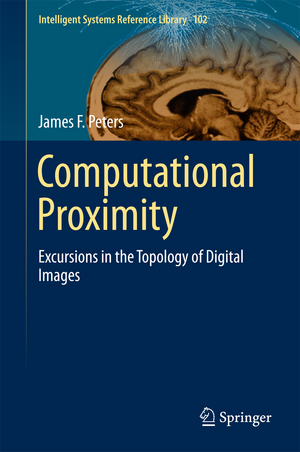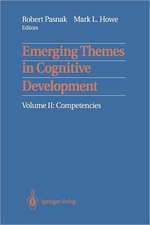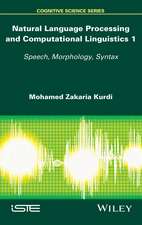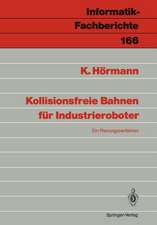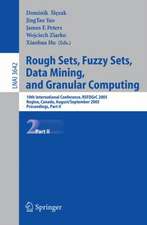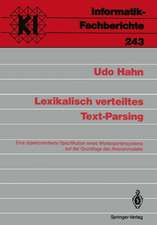Computational Proximity: Excursions in the Topology of Digital Images: Intelligent Systems Reference Library, cartea 102
Autor James F. Petersen Limba Engleză Hardback – 29 apr 2016
| Toate formatele și edițiile | Preț | Express |
|---|---|---|
| Paperback (1) | 653.71 lei 6-8 săpt. | |
| Springer International Publishing – 22 apr 2018 | 653.71 lei 6-8 săpt. | |
| Hardback (1) | 660.16 lei 6-8 săpt. | |
| Springer International Publishing – 29 apr 2016 | 660.16 lei 6-8 săpt. |
Din seria Intelligent Systems Reference Library
- 20%
 Preț: 1050.57 lei
Preț: 1050.57 lei - 20%
 Preț: 1157.60 lei
Preț: 1157.60 lei - 20%
 Preț: 648.44 lei
Preț: 648.44 lei - 20%
 Preț: 650.08 lei
Preț: 650.08 lei - 20%
 Preț: 1005.64 lei
Preț: 1005.64 lei - 5%
 Preț: 968.88 lei
Preț: 968.88 lei - 20%
 Preț: 1052.67 lei
Preț: 1052.67 lei - 20%
 Preț: 1171.46 lei
Preț: 1171.46 lei - 20%
 Preț: 1164.84 lei
Preț: 1164.84 lei - 20%
 Preț: 815.83 lei
Preț: 815.83 lei - 20%
 Preț: 989.96 lei
Preț: 989.96 lei - 20%
 Preț: 1063.41 lei
Preț: 1063.41 lei - 20%
 Preț: 925.45 lei
Preț: 925.45 lei - 20%
 Preț: 504.37 lei
Preț: 504.37 lei - 18%
 Preț: 1113.26 lei
Preț: 1113.26 lei - 20%
 Preț: 1920.04 lei
Preț: 1920.04 lei - 20%
 Preț: 990.62 lei
Preț: 990.62 lei - 20%
 Preț: 651.57 lei
Preț: 651.57 lei - 20%
 Preț: 645.97 lei
Preț: 645.97 lei - 20%
 Preț: 647.13 lei
Preț: 647.13 lei - 20%
 Preț: 654.05 lei
Preț: 654.05 lei - 20%
 Preț: 649.93 lei
Preț: 649.93 lei - 20%
 Preț: 648.11 lei
Preț: 648.11 lei - 20%
 Preț: 657.99 lei
Preț: 657.99 lei - 20%
 Preț: 656.84 lei
Preț: 656.84 lei - 20%
 Preț: 1624.04 lei
Preț: 1624.04 lei - 20%
 Preț: 642.98 lei
Preț: 642.98 lei - 20%
 Preț: 649.60 lei
Preț: 649.60 lei - 20%
 Preț: 651.23 lei
Preț: 651.23 lei - 20%
 Preț: 653.06 lei
Preț: 653.06 lei - 20%
 Preț: 1002.99 lei
Preț: 1002.99 lei - 20%
 Preț: 645.14 lei
Preț: 645.14 lei - 20%
 Preț: 658.33 lei
Preț: 658.33 lei - 20%
 Preț: 644.98 lei
Preț: 644.98 lei - 20%
 Preț: 646.62 lei
Preț: 646.62 lei
Preț: 660.16 lei
Preț vechi: 825.20 lei
-20% Nou
Puncte Express: 990
Preț estimativ în valută:
126.32€ • 131.89$ • 104.55£
126.32€ • 131.89$ • 104.55£
Carte tipărită la comandă
Livrare economică 05-19 aprilie
Preluare comenzi: 021 569.72.76
Specificații
ISBN-13: 9783319302607
ISBN-10: 3319302604
Pagini: 433
Ilustrații: XXVIII, 433 p. 254 illus., 39 illus. in color.
Dimensiuni: 155 x 235 x 25 mm
Greutate: 0.82 kg
Ediția:1st ed. 2016
Editura: Springer International Publishing
Colecția Springer
Seria Intelligent Systems Reference Library
Locul publicării:Cham, Switzerland
ISBN-10: 3319302604
Pagini: 433
Ilustrații: XXVIII, 433 p. 254 illus., 39 illus. in color.
Dimensiuni: 155 x 235 x 25 mm
Greutate: 0.82 kg
Ediția:1st ed. 2016
Editura: Springer International Publishing
Colecția Springer
Seria Intelligent Systems Reference Library
Locul publicării:Cham, Switzerland
Cuprins
Computational Proximity.- Proximities Revisited.- Distance and Proximally Continuous.-Image Geometry and Nearness Expressions for Image and Scene Analysis.- Homotopic Maps, Shapes and Borsuk-Ulam Theorem.- Visibility, Hausdorffness, Algebra and Separation Spaces.- Strongly Near Sets and Overlapping Dirichlet Tessellation
Regions.- Proximal Manifolds.-Watershed, Smirnov Measure, Fuzzy Proximity and Sorted Near Sets.- Strong Connectedness Revisited.- Helly’s Theorem and Strongly Proximal Helly Theorem.- Nerves and Strongly Near Nerves.- Connnectedness Patterns.- Nerve Patterns- Appendix A: Mathematica and Matlab Scripts.- Appendix B: Kuratowski Closure Axioms.- Appendix C: Sets. A Topological Perspective.- Appendix D: Basics of Proximities.- Appendix E: Set Theory Axioms, Operations and Symbols.- Appendix F: Topology of Digital Images.
Textul de pe ultima copertă
This book introduces computational proximity (CP) as an algorithmic approach to finding nonempty sets of points that are either close to each other or far apart. Typically in computational proximity, the book starts with some form of proximity space (topological space equipped with a proximity relation) that has an inherent geometry. In CP, two types of near sets are considered, namely, spatially near sets and descriptivelynear sets. It is shown that connectedness, boundedness, mesh nerves, convexity, shapes and shape theory are principal topics in the study of nearness and separation of physical aswell as abstract sets. CP has a hefty visual content. Applications of CP in computer vision, multimedia, brain activity, biology, social networks, and cosmology are included. The book has been derived from the lectures of the author in a graduate course on the topology of digital images taught over the past several years. Many of the studentshave provided important insights and valuable suggestions. The topics in this monograph introduce many forms of proximities with a computational flavour (especially, what has become known as the strong contact relation), many nuances of topological spaces, and point-free geometry.
Caracteristici
Introduces descriptive proximity spaces and the generation of set patterns in proximity spaces, leading to new forms of topological spaces and new forms of algebraic structures such as near groups useful in solving pattern generation, pattern recognition, digital image analysis, retrieval and classification problems Presents a complete framework for the practical applications in descriptive proximity spaces Written by a leading expert in the field Includes supplementary material: sn.pub/extras
